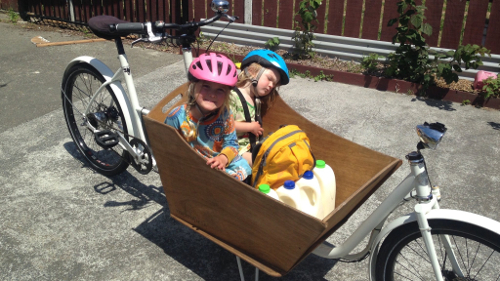
The new Tappan Zee Bridge (officially the Governor Mario M. Cuomo Bridge) will have a fantastic "Shared Use Path" for people walking, biking, etc. Unfortunately, the State's plan is unsafe, and intends to close the path overnight.
19 organizations came together, conveying the problems and solutions to the Governor (letter below).
January 17, 2018
To: Andrew Cuomo <governor.cuomo@ny.gov>
Cc: Ali Chaudhry <ali.chaudhry@exec.ny.gov>
We sincerely appreciate the Thruway Authority providing a Shared Use Path (SUP) on the Governor Mario M. Cuomo Bridge. It can be an important transportation, tourism and recreation resource for the region and the nation. However, there are two main challenges to that goal we hope you'll help overcome.
First, the SUP must be open and usable at all hours. Any other policy means the State would be making choices for people on when, how, and even if, they can travel — hampering economic opportunities, traffic safety and environmental justice.
Second, non-standard designs are proposed around the Path's western terminus. The plans create safety and accessibility issues which both pose liabilities to the Authority and diminish the Path's usability.
Details of these problems, recommended solutions and resources are addressed in the attached pages.
We trust you will take the steps necessary to ensure the local and national active transportation and disability communities can praise the Governor Mario M. Cuomo Bridge as an example to the nation that you produce first class, safe infrastructure.
Please let us know the status of these issues by January 31 so we can relay that information to our membership.
Sincerely,
 |
Daniel Convissor Bike Tarrytown |
 |
Dave Zornow Bike Nyack |
 |
Ken McLeod League of American Bicyclists |
 |
Ian Thomas America Walks |
 |
Virginia Sullivan Adventure Cycling Association |
 |
Kenneth Podziba Bike New York |
 |
Ed Sobin Appalachian Mountain Club NY / NJ |
 |
Christy Guzzetta New York Cycle Club |
 |
Cyndi Steiner New Jersey Bike & Walk Coalition |
 |
Steve Vaccaro Five Boro Bicycle Club |
 |
James Weisman United Spinal |
 |
Edith M Prentiss Disabled In Action of Metro NY |
 |
Stephen Brehl Rockland Bicycle Club |
 |
Bob Hermann Westchester Cycle Club |
 |
Michael Reade Wallkill Valley Rail Trail Association |
 |
Marc Soloff Bicycle Touring Club of North Jersey |
 |
Emily Flynn Bike Friendly Kingston |
 |
David Gordon Mid Hudson Bicycle Club |
| Rona Shapiro Yonkers Bike Club |

Hand crank cycle (New Mobility)

A "long john" bike with kids in it (hooplakids.nz)

Bike trailer with tall cargo

Raised intersection (FHWA)

Pedestrian / bicycle crossing signs (MUTCD W11-15)

Bikes yield to pedestrian signs (MUTCD R9-6)

Turning vehicle yield sign (Flat Iron Bike)

Narrow Lane Assembly (NYSDOT)
Bridges operated by New York City and the MTA are open overnight, without incident or disruption to local residents. The same is true the world over where governments value the liberty bicycles offer citizens.
Villages on both sides of the river are planning networks of safe infrastructure for people walking and biking. This will result in normal people using their feet and bikes for getting to work, school, friends, shopping, restaurants. Such trips will be made at all hours of the day and night, just like people driving do.
Most notably, there will be a strong constituency of Rockland County residents cycling to Tarrytown's Metro-North station. Trains stop there 22 hours per day. Off-hour commutes are prime for cycling because bus service either isn't available or infrequent.
Both the bike infrastructure network and improved Metro North access open up job opportunities for people who don't drive cars.
Naturally, there will occasionally be times when maintenance operations require closing the SUP. During those periods, a shuttle service is a reasonable alternative.
Bicycle dismount signs are planned in two locations. Current standards do not use such signs. They're not even specified in the Manual on Uniform Traffic Control Devices (MUTCD). (See Part 9B at https://mutcd.fhwa.dot.gov/htm/2009/)
Requiring people riding bikes to dismount is a non-standard practice. It introduces unnecessary risks. (http://www.bccc.bc.ca/dismount)
Current techniques call for the use of bicycle yield to pedestrian signs (MUTCD R9-6).
The current proposal places gates across the Path and the Esposito Trail where they reach the South Franklin St / Clinton Ave intersection. People would have to push though crossbars 30" above the ground. That concept has a variety of problems.
Several nationally recognized active transportation professionals we reached out to said they knew of no guidelines supporting gates, nor of similar precedents. They raised concerns about the gates being onerous and prohibitive, especially for the less physically able.
See the attached photos for examples of people who would be limited by these gates. Please also examine A Guide to Inclusive Cycling, an excellent resource on the topic of designing paths for full accessibility. (Available at http://wheelsforwellbeing.org.uk/)
Given the volume of people that will be using the SUP, some of whom will come in large groups, the gates will result in queues that back up into the street.
If safety is the motivating factor for the gates, plans for the intersection would realize that people using the paths still need to cross Clinton Ave and/or South Franklin St whether or not gates are installed.
This intersection includes an exit from the Thruway. People driving off highways are both prone to speeding due to velocitization, and they're desensitized to the presence of people biking and walking. And there will be thousands of people walking and cycling here each day. Thus it's essential to use strong traffic calming and signage techniques:
The unusual design choices on the trail and the lack of traffic calming on the roads opens the Authority, State and South Nyack to safety liabilities affirmed by Turturro v. City of New York (NYS Court of Appeals, No. 196, 2016).
The decisions and the process of making them could present grounds for Article 78 proceedings.
biketarrytown.org | info@biketarrytown.org | B: @biketarrytown.bsky.social | F: @BikeTarrytn